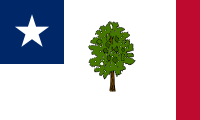Flag of Mississippi facts for kids
 |
|
| Name | The "In God We Trust" flag, The New Magnolia |
|---|---|
| Use | Civil and state flag |
| Proportion | 3:5 |
| Adopted | January 11, 2021 |
| Designed by | Rocky Vaughan, Sue Anna Joe, Kara Giles, Dominique Pugh, and Micah Whitson |
The flag of Mississippi features a white magnolia blossom surrounded by the words "In God We Trust" and 21 stars, on a red field with a gold-bordered blue Canadian pale. The northernmost star is composed of a pattern of five diamonds, an Indigenous symbol. It was adopted on January 11, 2021 and replaced the previous flag that displayed the Confederate battle insignia in the upper left hand corner.
The contest to replace the Confederate-based state flag had been precipitated by the George Floyd protests, and the old flag was retired on June 30, 2020.
Mississippi has had three official state flags in its history. The first flag, known as the "Magnolia Flag", was adopted in 1861 and consisted of a "Flag of white ground, a magnolia tree in the centre, a blue field in the upper left hand corner with a white star in the centre, ... with a red border and a red fringe at the extremity of the Flag". The Magnolia Flag was declared to be "null and void" by a state constitutional convention in 1865 and the state was left without an official flag until the second one was adopted in 1894.
The second flag, designed by Edward N. Scudder and adopted in 1894, consisted of a triband of three equal horizontal stripes of blue, white, and red, with the canton of the Confederate battle flag. The thirteen stars on the state flag officially represented "the number of the original states of the Union", although they are sometimes thought to be for the states that seceded from the Union plus Missouri and Kentucky, which also had both Confederate and Union governing bodies. From 1894 to 1956, and again from 2003 to 2020, this was the only state flag to incorporate the Confederate battle flag into its design. During this time, state legislators proposed new flag designs omitting the Confederate symbols.
On June 27, 2020, Governor Tate Reeves stated that if the Mississippi Legislature passed a bill that weekend addressing the flag issue, he would sign it into law. Subsequently, on June 28, 2020, the Legislature passed a bill to repeal the sections of the Mississippi State Code which made provisions for a state flag, mandate the Mississippi Department of Archives and History develop a plan for the removal of the former flag from public buildings within 15 days of the bill's effective date, and establish a commission to design a replacement that would exclude the Confederate battle flag and include the U.S. national motto "In God We Trust". Reeves then signed it into law on June 30, 2020.
The third flag was designed by Rocky Vaughan, Sue Anna Joe, Kara Giles, Dominique Pugh, and Micah Whitson. It was chosen by the Commission to Redesign the Mississippi State Flag, which was established by the same June 2020 Mississippi House bill which retired the second flag. The commission received thousands of submissions, and narrowed them down to a single choice, which was submitted for public vote as a ballot measure on November 3, 2020. Voters approved the new design in a two-choice vote but the removal of the Confederate battle flag from the new proposed design was never approved by voters directly. It is one of three U.S. state flags to feature the words "In God We Trust" (the U.S. national motto), with the other two being those of Florida and Georgia.
Contents
Pledge to the Mississippi state flag
The pledge to the state flag is:
I salute the flag of Mississippi and the sovereign state for which it stands with pride in her history and achievements and with confidence in her future under the guidance of Almighty God.
—Mississippi Code Ann., Section 37-13-7, 1972
The statute is part of the set of state statutes that governs the curriculum of the state's public schools. Section 37-13-7 provides: "The pledge of allegiance to the Mississippi flag shall be taught in the public schools of this state, along with the pledge of allegiance to the United States flag."
History
Bonnie Blue flag
Prior to 1861 Mississippi, like most U.S. states, had no official state flag. When Mississippi declared its secession from the Union on January 9, 1861, near the start of the American Civil War, spectators in the balcony handed a Bonnie Blue Flag down to the Secession Convention delegates on the floor, and one was raised over the capitol building in Jackson as a sign of independence. Later that night residents of Jackson paraded through the streets under the banner. Harry McCarthy, a singer and playwright who observed the parade, was inspired to write "The Bonnie Blue Flag", which, after "Dixie", was the most popular song in the Confederacy.
1861 flag
The first official flag of Mississippi was known as the Magnolia Flag. It was the official flag of the state from 1861 until 1865. It remained in use as an unofficial flag until 1894, when the current state flag was first adopted. On January 26 the delegates to the Secession Convention approved the report of a special committee that had been appointed to design a coat of arms and "a suitable flag". The flag recommended by the committee was "A Flag of white ground, a Magnolia tree in the centre, the Flag to be finished with a red border and a red fringe at the extremity of the Flag." Due to time constraints and the pressure to raise “means for the defense of the state,” the delegates neglected to adopt the flag officially in January but did so when they reassembled in March. The Magnolia Flag was not widely used or displayed during the Civil War, as the various Confederate flags were displayed more frequently. The Magnolia Flag remained the official state flag of Mississippi until 1865.
Following the conclusion of the Civil War, a constitutional convention assembled in Jackson on August 22, 1865, began to revoke and repeal many of the actions taken by the Secession Convention of 1861. Among those repealed was the ordinance adopting a coat of arms and a state flag, leaving Mississippi without an official flag.
1894 flag
In 1906 Mississippi adopted a revised legal code that repealed all general laws that were not reenacted by the legislature or brought forward in the new code. The 1906 legal code did not bring forward the law that created an official state flag and a coat of arms. Because of this oversight, likely inadvertent, the state of Mississippi did not have an official state flag from 1906-2001. Nonetheless, the 1894 flag continued to be used as the de facto state flag until it was officially readopted by the state legislature on April 17, 2001. There had been widespread protests by some African-American and other civil rights groups about adopting the flag with the Confederate emblem.
The Mississippi Code of 1972, in Title 3, Chapter 3, describes the flag as follows:
§ 3-3-16. Design of state flag. The official flag of the State of Mississippi shall have the following design: with width two-thirds (2/3) of its length; with the union (canton) to be square, in width two-thirds (2/3) of the width of the flag; the ground of the union to be red and a broad blue saltire thereon, bordered with white and emblazoned with thirteen (13) mullets or five-pointed stars, corresponding with the number of the original States of the Union; the field to be divided into three (3) bars of equal width, the upper one blue, the center one white, and the lower one, extending the whole length of the flag, red (the national colors); this being the flag adopted by the Mississippi Legislature in the 1894 Special Session.
2001 flag referendum
In 2000 the Supreme Court of Mississippi ruled that the state legislature in 1906 had repealed the adoption of the state flag in 1894. What was considered to be the official state flag was only so through custom or tradition during the previous 94 years. The flag was officially readopted on April 17, 2001.
In January 2001 former Mississippi governor Ronnie Musgrove appointed an independent commission which developed a new proposed design. On April 17, 2001, a non-binding state referendum to change the flag was put before Mississippi voters. The proposal would have replaced the Confederate battle flag with a blue canton with 20 stars. The outer ring of 13 stars would represent the original Thirteen Colonies, the ring of six stars would represent the six nations that have had sovereignty over Mississippi Territory (various Native American nations as a collective nation, French Empire, Spanish Empire, Great Britain, the United States, and the Confederacy), and the inner and slightly larger star would represent Mississippi itself. The 20 stars would also represent Mississippi's status as the 20th member of the United States. The referendum for a new flag was defeated in a vote of 64% (488,630 votes) to 36% (267,812), and the 1894 flag was retained.
Images for kids
See also
 In Spanish: Bandera de Misisipi para niños
In Spanish: Bandera de Misisipi para niños




